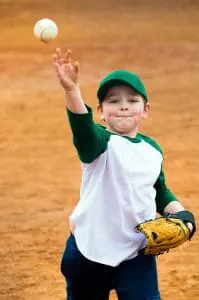Teaching throwing and catching to your students soon?
You don’t want to miss these pointers from Dr. Bob Pangrazi!
Catching and throwing are complex motor patterns. Most complex skills should be practiced at normal speed. Whereas some locomotor skills can be slowed down to promote learning, doing so with complex skills such as throwing, striking, or kicking destroys the rhythm and force generation required to throw maturely. Consider the following teaching points when practicing throwing:
Throwing
One of the least effective ways to practice throwing or catching is to have students find a partner. Undoubtedly, one partner can throw harder than the other and catching is difficult. Neither partner will be allowed to throw with maximum force because accuracy and catching the throws will be difficult.
- Provide a variety of objects to throw, so students learn how varying weight and diameter affects throwing distance and speed.
- When children are learning to throw, stress distance and velocity, not accuracy. Throwing for accuracy hampers development of a mature throwing form. Tell students to “throw as hard and far as possible.”
- Avoid practicing throwing and catching at the same time. Many children’s throws will be inaccurate and hard for a partner to catch. Have them practice throwing against a wall (velocity) or on a large field (distance).
- Use floor markers like carpet squares or circles drawn on the floor to teach children proper foot movement (stepping forward and off the square or out of the circle).
- Beanbags and yarn balls are excellent for developing throwing velocity because they do not roll and travel as far as other objects
Catching
Catching uses the hands to stop and control a moving object. Catching is harder to learn than throwing, because children must track the object while moving into its path. Children usually develop mature throwing patterns before they display mature catching patterns. Catching is also hard to master due to the fear of being hurt by the oncoming object. When teaching the early stages of catching, use balloons, fleece balls, beach balls, and foam balls—because they move slowly, make tracking easier, and do not hurt if they hit a child in the face.
- It is natural to dodge an object that may cause harm. Remove the fear factor by using projectiles that will not hurt children, such as foam balls, yarn balls, beach balls, and balloons.
- Use smaller projectiles as students improve their catching skills. Larger objects move more slowly and are easier to track visually.
- Prepare students for a catch by asking them to focus on the ball while it is in the thrower’s hand. Use verbal cues such as “Look (focus), ready (for the throw), catch (toss the ball).”
- Balls and background colors should strongly contrast to increase visual perception.
- Throwing the projectile at a greater height offers the child more opportunity to track it successfully. Beach balls move slowly throughout a high trajectory, giving children time to focus and move into the path of the oncoming object.
- Bounce objects off the floor so children learn to judge the rebound angle of a projectile.
Need “soft” activity balls for your Throwing & Catching Unit? Check out these great options from Gopher!






4 Responses
Thank you, this was very helpful
Thank you… this really helped me
The tips and throwing materials which you have listed I am already implementing on my Special athletes. I am special educator and National Trainer of Special Olympics, Bharat so often trying to find some more tips and guidance from expertise like you to develop their potential. Thanks so much and looking forward to learn some more from your side …..
It helped me with my assignment a lot. thank you!